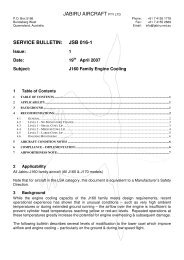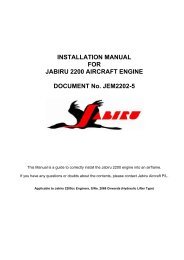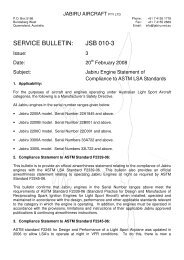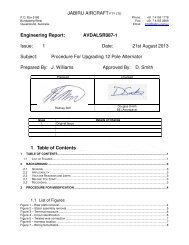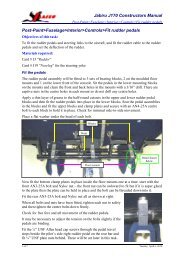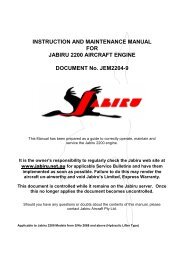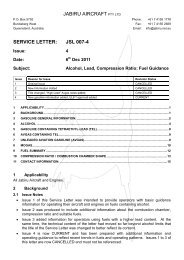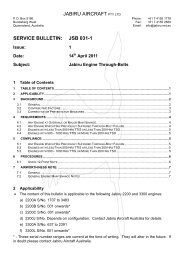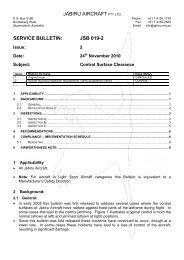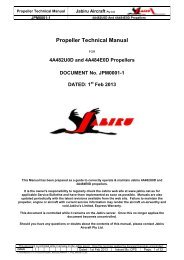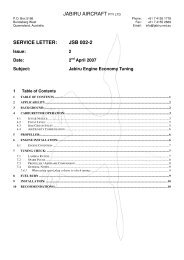INSTRUCTION AND MAINTENANCE MANUAL FOR ... - Jabiru Aircraft
INSTRUCTION AND MAINTENANCE MANUAL FOR ... - Jabiru Aircraft
INSTRUCTION AND MAINTENANCE MANUAL FOR ... - Jabiru Aircraft
Create successful ePaper yourself
Turn your PDF publications into a flip-book with our unique Google optimized e-Paper software.
<strong>Jabiru</strong> <strong>Aircraft</strong> Pty Ltd<br />
Instruction & Maintenance Manual<br />
Mobil Aero 100 (SAE 50) (EXXON Aero Elite 100)<br />
BP Aero Oil D100/BP Multigrade Aero Oil D SAE 20 W 50<br />
Aero Shell W 100 Plus<br />
<strong>Jabiru</strong> 3300 <strong>Aircraft</strong> Engine<br />
Hydraulic Valve Lifter Models<br />
The normal running oils are detergent and ashless dispersant types. See <strong>MAINTENANCE</strong><br />
SECTION 5.3<br />
Oil capacity:<br />
The new engine will hold 3.4 litres with an oil cooler.<br />
On subsequent oil changes the engine will hold approx 3.2 litres.<br />
Do not use any type of automotive oil. Aviation oils have been blended specifically for the<br />
difficult operating conditions found in an air cooled aero engine operation and using automotive<br />
will be extremely detrimental to its operation.<br />
When you change oil from the “run in” type to the “normal” oil at or around 25 hrs replace oil<br />
filter. You may want to cut the filter open for inspection. It is usual in <strong>Jabiru</strong> engines to find a<br />
small amount of aluminium but definitely no metal. If bearing metal is present contact the<br />
<strong>Jabiru</strong> Service Department.<br />
11.2.3 Engine Cooling<br />
Avoid prolonged ground running at elevated RPM. Engine can be over heated during ground<br />
operations – remember air ducts are designed for in flight cooling. Ground running at power<br />
settings above idle requires special, oversize cooling ducts and oil coolers.<br />
Do not apply full power until CHT has reached at least 100°C (212°F)<br />
ALWAYS TAKE OFF AT FULL POWER – especially when the engine is new.<br />
For the first few take offs climb at a higher airspeed than normal to assist engine cooling.<br />
Reduce power at cross wind leg and shallow climb (lower nose).<br />
Avoid high nose altitude continual climbs. The higher the climb out speed the better for engine<br />
cooling. No low speed high nose altitude climb outs.<br />
RETORQUE heads on annual inspection.<br />
The ducts supplied with the engine need to be fitted. See Installation manual. Occasionally,<br />
periodic research and development dictates that changes must occur to cooling ducts. The<br />
ducts supplied with new engines will the latest types and may differ to those supplied with older<br />
engines.<br />
11.2.4 Consumables<br />
Filters – Regular inspections are a must for fuel and air filters. Conditions will dictate when<br />
changed. The air box has a rubber flap to give partial inspection of air filter.<br />
Spark Plugs - NGK D9EA are recommended. Refer to main body of this manual for plug gap.<br />
Remember that plugs are installed at around 8 ft lb or given 1/2 turn after contact with head.<br />
18mm Plug spanner used.<br />
11.2.5 Starting<br />
A warm idle of around 900 RPM will automatically create the right starting environment. As the<br />
engine is run-in on a dynamometer the Idle set screw may have to be adjusted to give 900<br />
RPM idle when warm.<br />
This document is controlled while it remains on the <strong>Jabiru</strong> server. Once this no longer applies the document becomes uncontrolled.<br />
REVISION 0 1 2 3 4 5 6 7 8 9 Dated : Apr 2011 Issued By: DPS Page: 45 of 53<br />
L:\files\Manuals_For_Products\Engine_Manuals\3300_engine_manuals\Hydraulic_Lifters\Working_Copies\JEM3304-9_I&M.doc





